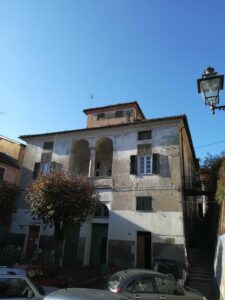In 1750, the town was called “Crux”, ‘cross’ in Latin, to which in 1733 the “surname” Fieschi was added, since these Genoese nobles had been lords of this place since 1253.
The first mention of the village dates back to the 11th century, when the bishops of Tortona had a castle built on the mountain behind the town, today called Monte Castello. It became the domain of the marquises of Gavi from 1140 to 1198 and then returned to the possession of the bishops of Tortona. In the 12th century it came under the dominion of the Malaspina family at the behest of Emperor Frederick Barbarossa. At the end of the 13th century, the town returned to the possession of the Marquises of Gavi. The Marquis Guglielmo sold it shortly afterwards to the Municipality of Genoa. Around the middle of the 13th century, the fiefdom of Savignone, also including Croce, passed under the control of the Fieschi family, counts of Lavagna. The two fiefdoms, Savignone and Croce, were then administratively divided in 1678. The dominion of the Fieschi family lasted until 1797, when the Imperial Fiefdoms were suppressed by Napoleon Bonaparte. The last feudal lord was Agostino Innocenzo Fieschi; the French soldiers, before being able to occupy the town, were opposed for a long time by a handful of rebels, led by a certain Cavero, who had occupied the impervious Repasso area, behind the Borgo. The situation came to a head when a proud supporter of Napoleon, Antonio De Ferrari, led Napoleon’s soldiers through the Repasso paths, taking the rebels and Austrian soldiers, who were garrisoning the town, by surprise. The town was sacked, the feudal houses devastated and the rebels executed in the Braia woods. Cavero managed to escape, taking refuge in Vienna, and returned only after the fall of Napoleon. Crocefieschi returned, on 2nd December 1797, to the Department of Western Ligurian Mountains, with Rivarolo as its capital, within the Ligurian Republic. On 28th April 1798, Crocefieschi became the capital of the 1st Canton of the Jurisdiction of the Western Ligurian Mountains and, from 1803, the main centre of the XIII canon of the Alta Valle Scrivia in the Department of Genoa, and then, in 1815, it was incorporated into the Kingdom of Sardinia.
What to see in Crocefieschi
- ANTICO CASTELLO
- CHIESA PARROCCHIALE DI SANTA CROCE
- PALAZZI DEI FIESCHI
- ORATORIO DI SAN GIOVANNI BATTISTA
- MUSEO PALEONTOLOGICO
Today only a few ruins of the ancient castle remain on the top of Monte Castello. The manor was mentioned in various documents of the 11th and 12th centuries and, most likely, it was built by the bishops of Tortona in the year 1000. It then passed to the marquises of Gavi who ceded its ownership to the Municipality of Genoa. According to a peace treaty of 1199, its total destruction was decided, with the Genoese undertaking not to rebuild it again.
The church is located in an elevated position compared to the historic centre of the town and was built at the expense of the population between 1578 and 1579, to replace the old parish church of San Martino di Parissione, in the hamlet of Vallegge, and rebuilt in 1686 with three naves. Inside there are two wooden statues attributed to the sculptor Anton Maria Maragliano and two 17th century paintings.
The construction of the two palaces along the mule track for the then hamlet of Vobbia was commissioned by the Fieschis between the 16th and 17th centuries. Originally they were three identical buildings, overlooking the current Town Hall square, however, towards the end of the 18th century, a fire destroyed one of them. The two remaining buildings were converted: the first into the Commisoner’s headquarters and the second into headquarters for the Mayor. Today, one of them is the municipal headquarters, while the other is used as a private home.
The oratory was built in 1596. From the outside all that appears is a small church nestled between the houses of the alley. Upon entering you discover a beautiful painting of the Baptism of Jesus and enormous and very particular crucifixes, which are carried through the streets of the town during processions.
The creator of the museum was the paleontologist Bruno Rattazzi who gave the exhibited material on free loan. The Museum houses around two hundred finds from the valleys of the Ligurian Apennines: Scrivia, Aveto, Trebbia, Borbera, territories traditionally little explored from a paleontological point of view. These finds are, above all, traces of invertebrate animals that lived on the bottom of a prehistoric sea, where they left signs as beautiful as works of art. It goes from the Miocene to the Upper Cretaco, therefore from 20 to 60 million years ago. The transformation of those seabeds into mountains, during the Alpine orogeny, changed the sands and seabeds into rock, forever fixing those traces excavated and designed by animals: it is mainly an iconological museum and the fossils were found in the Antola areas, Pagliaro, Montoggio, Savignone, Ranzano and Valle D’Aveto.
Lorem ipsum dolor sit amet, consectetur adipiscing elit. Ut elit tellus, luctus nec ullamcorper mattis, pulvinar dapibus leo.
Lorem ipsum dolor sit amet, consectetur adipiscing elit. Ut elit tellus, luctus nec ullamcorper mattis, pulvinar dapibus leo.
Lorem ipsum dolor sit amet, consectetur adipiscing elit. Ut elit tellus, luctus nec ullamcorper mattis, pulvinar dapibus leo.
















